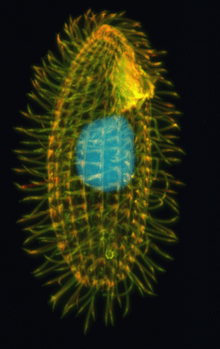Hymenostome
| Hymenostomes | |
|---|---|
 | |
| Tetrahymena thermophila | |
| Scientific classification | |
| Domain: | Eukaryota |
| (unranked): | SAR |
| (unranked): | Alveolata |
| Phylum: | Ciliophora |
| Class: | Oligohymenophorea |
| Order: | Hymenostomatida Delage & Hérouard 1896 |
| Typical families | |
|
Suborder Tetrahymenina | |
The hymenostomes are an order of ciliate protozoa. Most are free-living in freshwater, such as the commonly studied genus Tetrahymena, but some are parasitic on fish or aquatic invertebrates. Among these is the important species Ichthyopthirius multifiliis, a common cause of death in aquaria and fish farms.
The hymenostomes are fairly typical members of the Oligohymenophorea. Their body cilia are mostly uniform, sometimes with a few long caudal cilia, and arise from monokinetids or from dikinetids at the anterior. The oral cilia are in general distinctly tetrahymenal, with three membranelles and a paroral membrane, which corresponds only to the middle segment of the tripartite membranes found in certain scuticociliates. Mouth formation during cell division usually begins next to a postoral kinety.
The hymenostomes were first defined by Delage & Hérouard in 1896. Initially the scuticociliates and peniculids were included, then later treated as separate orders of a subclass Hymenostomatia, to which the astomes are sometimes added. More recently each of these groups tends to be treated as a separate subclass.